Author: Brian Armstrong, Coinbase; Translation: Biscuit, ChainCatcher
Recently, Coinbase co-founder and CEO Brian Armstrong shared his top 10 ideas in the cryptocurrency field, in response to the question “If you were to start a cryptocurrency company today, what would you choose?” These ideas cover various areas from finance, market, labor, privacy to the virtual world, exploring how to achieve innovation and improvement in the blockchain and cryptocurrency economy. The full translation by ChainCatcher is as follows:
In Short
-
Coinbase aims to update the financial system established over 100 years ago by supporting diverse cryptocurrency use cases, in order to create more economic freedom and opportunities worldwide.
-
In addition to internally developed products and services, Coinbase has also launched a request for entrepreneurs, which includes 10 exciting ideas.
-
In October this year, Coinbase Ventures will host its first summit in Los Angeles, bringing together outstanding builders to explore the development of the field together.
Sometimes I am asked, if you were to start another cryptocurrency company today, what would you choose? The cryptocurrency field is still in its early stages. Five years from now, many entrepreneurs will look back and wish they had started a cryptocurrency company in 2023. Bear markets are for building, so why not start today?
I have decided to share 10 of the most competitive ideas, hoping that someone will step forward and realize them. It will be challenging to put these ideas into action. Coinbase has a wealth of resources for building in the cryptocurrency field, but we don’t have the time to build everything and hope to help enable the ecosystem around us. We have already invested in some outstanding teams and are collaborating with them on some of these ideas. Most of these ideas have not been explored yet, and we need more people to get involved.
Currently, here are my main ideas, in no particular order:
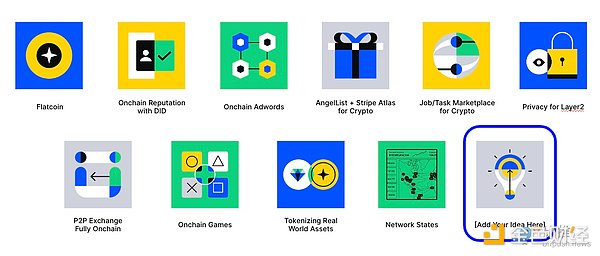
*Note: Coinbase Ventures has invested and will continue to invest in startups involving many of these themes. The following quotes some of these themes (not exhaustive).
Flatcoin
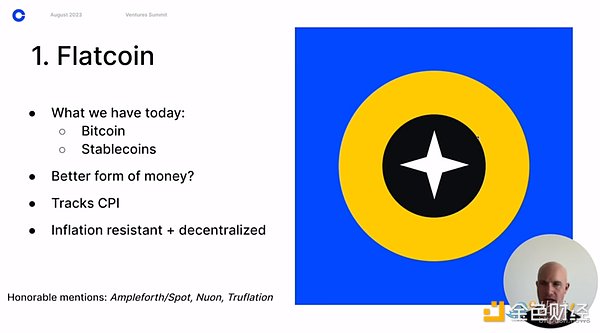
Bitcoin is considered the gold standard of the internet and the concept of a currency is great. However, due to its huge potential for appreciation, many people are now unwilling to use it as an actual currency. It still needs further development. Stablecoins backed by fiat currency are a good intermediate step, but they are still subject to problems such as inflation and seizure. So, what would a better form of currency created through cryptocurrency look like?
This currency may be completely decentralized (with anti-censorship) and track consumer price index (such as the US CPI) to maintain or approach purchasing power. It may require the support of a basket of assets to track the CPI or adopt algorithmic methods. There are even services like Truflation that offer the possibility of tracking on-chain inflation today to further achieve decentralization. Companies or protocols that are able to build better forms of cryptocurrency will have a significant impact.
On-chain reputation
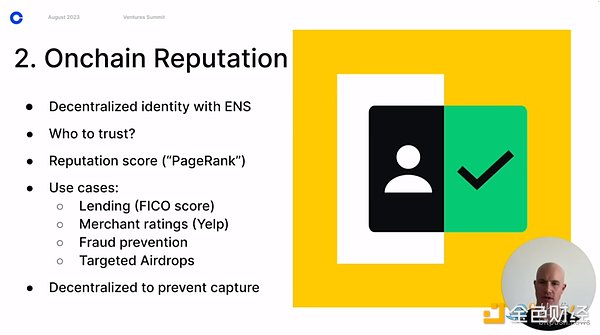
Although we already have decentralized identity systems like ENS, how do we know who is trustworthy? How do we know if a merchant is trustworthy? Or if we are sending funds to the real artist?
For this, we can build a decentralized protocol that allocates reputation scores to each address or ENS name based on on-chain data graphs. This is similar to how LianGuaigeRank rates each website based on incoming links and relevant metadata. This can be used for lending (decentralized FICO scores), merchant ratings (similar to Yelp), fraud prevention (wallets can issue warnings before sending funds to risky addresses), VIP airdrops, etc. This needs to be a decentralized protocol to prevent monopolization or abuse.
On-chain advertising
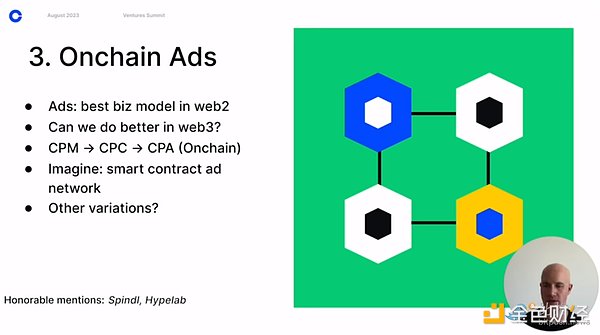
In Web 2, one of the most successful business models is advertising. It is reasonable to predict that some form of advertising will also play an important role in Web 3. Although Web3 developers and startups are willing to pay for distribution, can we do better than the traditional advertising model? In Web 2, the biggest innovation was the shift from paying per thousand impressions (CPM) to only paying when users click on the ad (CPC).
In Web 3, perhaps we explore only paying when users make on-chain purchases or take actions (CLianGuai). Imagine if any smart contract could publicly expose some metadata about how much they are willing to pay to incentivize users to execute function calls. The function call could accept the referrer’s address and pay a set commission. Indexing all smart contracts that support this advertising standard would create an inventory of ads.
Now, wallets and applications with a large user base can choose which ads or referral links to route requests to and share revenue when delivering to users. Real-time auction mechanisms will help find the best price. Of course, there may be other changes to advertising in Web 3, but the above is just an example.
On-chain capital
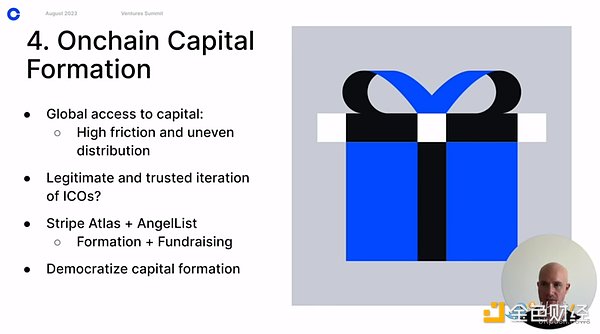
The ICO frenzy, despite facing many challenges including fraud and unregistered securities, had its reasons for the frenzy: there is still considerable friction in global capital formation and it is unevenly distributed. If you are an entrepreneur living in Budapest or Bangalore, opportunities to obtain funding may be fewer than for entrepreneurs in Silicon Valley or Cleveland. If fundraising becomes easier, we will see more startups emerge (this applies not only to startups but also to real people, such as fundraising for apartment buildings, etc.).
So, in a legal and trustworthy scenario, what will the next generation of ICO look like? Imagine a combination of Stripe Atlas and AngelList in Web 3, which not only helps you register a company or an idea (register in each country/region, submit documents, or use pseudonyms as a DAO), but also helps you raise funds for your ideas. Each idea can have promotional materials or videos, discussions and ratings, participant reputation, and transparent on-chain funds flow. Democratized fundraising could unleash enormous entrepreneurial potential worldwide.
Tasks for Cryptocurrencies
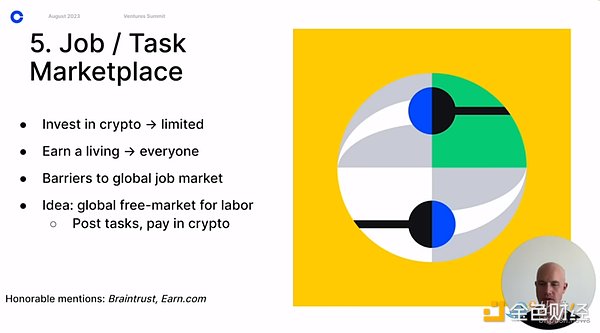
The global market has a limited population that can invest in cryptocurrencies, but almost everyone needs to make a living and allocate income for basic living needs. One major obstacle in the global job market is the difficulty in making cross-border payments to individuals. Why not create a more globalized and free labor market by allowing jobs and tasks to be posted in cryptocurrency form and helping employees and contractors find these jobs?
Second Layer Privacy
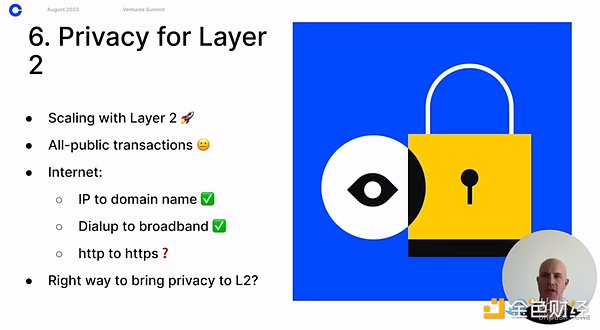
Although second-layer solutions have started to help scale cryptocurrencies, most transactions still occur on public blockchains. While transparency is beneficial in many cases, people do not want the majority of their economic transactions to be public. So, what is the right way to introduce privacy in second-layer solutions? Is it possible to build businesses in this field?
Fully On-Chain P2P Exchange
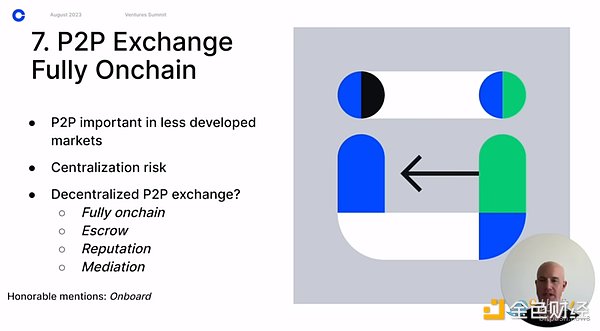
P2P exchanges for cryptocurrencies provide important entry and exit points for emerging and underdeveloped markets. However, these P2P exchanges are operated by centralized entities that may be forced to shut down, compromising individual freedom. Is there a way to establish a fully on-chain decentralized P2P exchange with custody, reputation, and arbitration features?
On-Chain Gaming
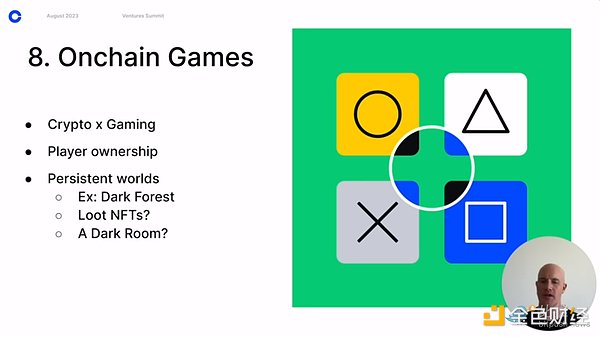
Although I am not an expert in the gaming field, I believe we have only scratched the surface of combining cryptocurrencies with gaming. How can players truly own the items they collect and use in games? How can these items survive in a persistent world (or dare I say, a “metaverse”) to create more complex interactions and economies?
Early examples like Dark Forest are exciting. Perhaps more games like Loot can be used. These games don’t have to be massive bestsellers; even simple games like “A Dark Room” can accommodate game items using NFTs, allowing players to own these items in a persistent virtual world coexisting with other players.
Tokenizing Real-World Assets
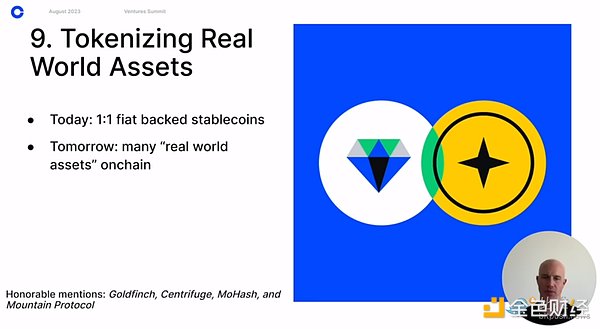
Stablecoins like USDC, which are backed by fiat currency in a 1:1 ratio, were among the earliest “real-world assets” to be implemented on the blockchain. We believe that over time, many forms of assets can and will be realized on open, permissionless blockchain networks, creating newfinancial infrastructure with programmability, composability, global 24/7 liquidity, and trust-minimized settlement. Many projects (including some companies in our portfolio) are exploring methods in this field, involving bonds, treasury bills, commodities, accounts receivable, and even high-end luxury goods.
Software for Launching and Managing Network States
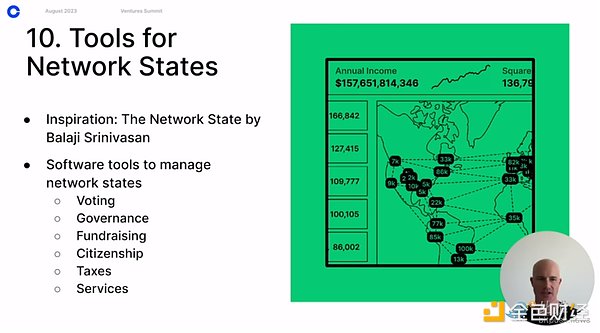
The concept of “network states,” proposed by Balaji Srinivasan, has accelerated the development of startup cities and network states. More network states will be launched in the future, and theywill require tools to manage voting, governance, fundraising, citizenship, tax collection, and service provision. Remember, this software will also be useful for many different types of startup cities and communities.
Like what you're reading? Subscribe to our top stories.
We will continue to update Gambling Chain; if you have any questions or suggestions, please contact us!